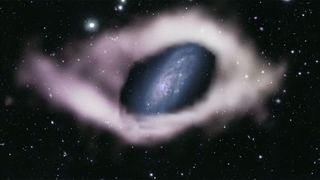Key Takeaways:
- Astronomers discovered an extremely rare polar ring galaxy, NGC 4632, using radio telescopes, unveiling a ring of hydrogen swirling around its poles.
- This galaxy type, polar ring galaxies, offers vital insights into the formation and growth of galaxies, providing clues about dark matter and the dynamics of galactic halos.
- NGC 4632’s hydrogen ring, accounting for about half of its mass, was likely absorbed from a companion galaxy, showcasing a unique and rare formation.
- The study, led by Nathan Deg at Queen’s University, emphasizes the significance of polar ring galaxies, not just for their beauty but for the wealth of information they hold about galactic evolution.
- Advanced telescopes like CSIRO’s Australian Square Kilometre Array Pathfinder (ASKAP) play a crucial role in unveiling the mysteries of distant galaxies, producing vast amounts of data for in-depth analysis.

Astronomers have recently made an extraordinary discovery that has sent ripples through the scientific community. They’ve stumbled upon an ultra-rare phenomenon, a sight so spectacular that it defies the conventional understanding of galactic formations. The revelation involves the unearthing of a polar ring galaxy, a cosmic structure that astounds with its unparalleled beauty and scientific significance.
Galaxies, these vast celestial entities, come in diverse shapes and sizes, each holding its own narrative of cosmic evolution. From the colossal elliptical giants to the swiftly spinning spiral marvels, the universe boasts an array of galactic formations. Yet, the recent discovery of NGC 4632 has rewritten the cosmic playbook. This spiral galaxy hosts an enthralling ring of hydrogen enveloping its poles, a sight rarely witnessed in the vast expanse of space.
Conventionally, our understanding of galaxies stemmed from optical images, capturing the radiant glimmers of distant stars. However, the cosmic secrets beyond the luminescent stellar disks remained shrouded in mystery until the advent of radio telescopes. These instruments unveiled a new dimension of exploration, mapping the ethereal glow of free-floating hydrogen atoms, whether within galaxies or lurking in the intergalactic voids.
The unveiling of NGC 4632’s colossal hydrogen ribbon encircling its spiral arms came to light through the meticulous observations facilitated by CSIRO’s Australian Square Kilometre Array Pathfinder (ASKAP) radio telescope. Nestled in the heart of Western Australia’s Wajarri Yamaji Country, this discovery marks a monumental leap in our comprehension of galactic dynamics. The findings, chronicled in a recent paper in Monthly Notices of the Royal Astronomical Society, elevate NGC 4632 into the elite category of “polar ring galaxies.”

Nathan Deg, leading the groundbreaking study at Queen’s University, emphasizes the rarity and sheer magnificence of polar ring galaxies. Beyond their aesthetic allure, these cosmic formations offer a treasure trove of clues deciphering the celestial evolution across cosmic timescales. NGC 4632’s hydrogen ring, constituting a substantial portion of its mass, likely originated from a neighboring galaxy, adding a layer of intrigue to its cosmic narrative.
The implications of these polar rings extend far beyond their captivating appearance. Their positioning and movement serve as celestial signposts, illuminating the contours of the enigmatic dark matter halos enveloping most galaxies. Spiral galaxies like NGC 4632, rich in cold hydrogen gas, harbor the cosmic fuel that ignites the birth of new stars, extending far beyond the luminous boundaries of their stellar disks.
Exploring the outskirts of spiral galaxies unravels curious phenomena, often witnessing the contortion of gas disks. These warps, induced by gravitational tugs from neighboring galaxies, embody a common cosmic tango wherein galaxies grow by siphoning gas from their companions. Such interactions, akin to our Milky Way’s history of consuming smaller cosmic cohorts, sculpt the diverse tapestry of galactic structures strewn across the cosmos.

My fascination with polar ring galaxies traces back to the pioneering work of astronomers Penny Sackett and Linda Sparke in the 1990s. Collaborating with Magda Arnaboldi, our endeavors delved into the mysteries of nearby galaxies, scrutinizing hydrogen within NGC 4650A using CSIRO’s Australia Telescope Compact Array (ATCA) on Gomeroi Country, unraveling the cosmic complexities concealed within.
The pursuit of unraveling cosmic mysteries led to pivotal projects like the HI Parkes All Sky Survey (HIPASS) and the Local Volume HI Survey (LVHIS), laying the groundwork for extensive research on galaxies. ASKAP’s inception marked a watershed moment, catalyzing the Wallaby project’s birth, aiming to conduct an expansive survey of hydrogen in the local cosmic neighborhood.
The full potential of ASKAP, operational since late 2022 at CSIRO’s Murchison radio astronomy observatory, transcends mere observation. Its colossal data output necessitates dedicated software housed in the Setonix supercomputer in Perth. This computational prowess sieves through astronomical data, unveiling the elusive traces of hydrogen in distant galaxies, paving the path for detailed analyses of the most intriguing cosmic entities.
The latest research highlights the discovery of two galaxies among the 600 surveyed in the pilot study, shedding light on their peculiar structures. Deg’s excitement about uncovering potential polar ring galaxies hints at the possibility of these celestial marvels being more prevalent than previously envisaged. Visualization tools, including 3D renderings and virtual reality software like iDaVIE, aid in comprehending the intricate shapes and dynamics of these enigmatic cosmic entities.
Envisioning the full Wallaby survey’s scope unveils a staggering projection of over 200,000 hydrogen-rich galaxies. Among this cosmic ensemble lie numerous enigmatic entities akin to NGC 4632’s polar ring, promising profound insights into the elusive nature of dark matter and the cosmic choreography orchestrating galactic evolution.
The journey into the cosmic depths, propelled by advanced telescopes like ASKAP, continues to unfurl the tapestry of cosmic marvels. Each discovery heralds a new chapter in our quest to decipher the celestial symphony, offering glimpses into the intricate dance of galaxies and the cosmic forces shaping our vast universe.

